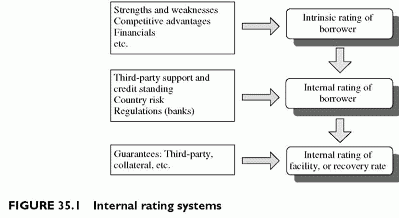INTERNAL RATING SYSTEMS
Category: Risk Management in Banking
Internal rating systems are not public and are customized to each banks needs. There is a strong tendency towards harmonization due to the new regulations putting the rating system in a central position for evaluating capital requirements. Since capital requirements affect pricing, the banking industry needs common benchmarks. Banks have exposure to all sorts of counterparties and across industries and countries. Therefore, all banks also need ratings for various types of entities: corporate firms; banks; country ratings.
Like external ratings, internal ratings are grades assigned to borrowers or facilities for ranking their risk relative to each other. Unlike external ratings, the counterparties of banks are usually non-rated entities, such as small or medium size businesses. Internal ratings isolate the borrowers risk from the facility risk, which depends on how secured it is. Internal ratings result from a review of both borrowers and facility characteristics.
Typical components of internal rating systems include:
• Borrowers risk.
• Eventual support from a supporting entity, typically a holding company supporting a subsidiary.
• Facility risk (a facility being any transaction), the equivalent to a debt issue for public firms.
The intrinsic borrowers risk is the risk of a corporate as a standalone entity. The support of another entity can strongly affect the risk of the couple primary borrower + supporting entity. Facilities might benefit from a wide spectrum of guarantees, strongly mitigating the credit risk.
Support plays a major role in enhancing intrinsic ratings. The support can be formal, for government owned companies for instance. In general, support designates a less formal relationship linking a holding company to its subsidiary. If the subsidiary is in the core business of the parent company, chances are that the parent company will not let it down. To assess support, it is necessary to assess the credit standing of the direct borrower, that of the supporting entity and the strength of the support. Combining support assessment with intrinsic rating provides the borrowers overall rating.
For facilities, other factors mitigate credit risk, mainly the seniority level and the guarantees attached to single facilities. Hence, a well-collateralized facility might have a good rating even though the borrower has a poor credit standing. Facility ratings are not the rule for banks internal systems. The risk mitigants of a facility relate directly to recovery in the event of default. Recovery rates based on experience, type of transaction and type of guarantee now serve as a substitute for facility ratings, sometimes used. Chances are that these forfeits will evolve into hard data with historical statistics from default built up under the incentives of the regulators.
Internal ratings of banks should ideally include:
• The intrinsic rating of the borrower.
• In the presence of a supporting entity: -The rating of the supporting entity;
-A rating qualifying the intensity of support of a parent company if any.
• The overall borrower rating, given the intrinsic rating, the supporting entity rating and the assessment of support.
• An assessment of the guarantees, which should be converted into a recovery rate of loss given default rate for capital requirement purposes. It is desirable to differentiate recovery rates according to the nature of guarantees.
Rating systems require business rules for implementation. A common and important example are the rules relating sovereign risk to corporate or banking borrowers. When country risk materializes as transfer risk, it becomes unfeasible to recover cash from a local borrower. This is a rationale for capping intrinsic borrowers ratings by the country rating. If the latter materializes, the lender faces a default due to transfer, even though the borrowers credit standing remains unaffected. There is a strong case, however, for splitting country and borrower risks rather than linking them mechanically, because local borrowers might be in good shape while the countrys credit standing has declined. The local borrowers credit standing is probably adversely affected by the countrys local situation. Country crises materialize by the deterioration of the credit standing of local private entities. Similar links exist between the quality of banking supervision and banks ratings. If the supervision process is loose, chances are that the banks information is less reliable. If it is stringent, using the intrinsic rating of banks and of holding companies based on their financial situation is more reliable. In this case, we split again the rating process into a two-stage process: the assessment of the supervisory process and that of the banks risk based on the banks specifics.
Figure 35.1 summarizes a possible structure for a rating system.

